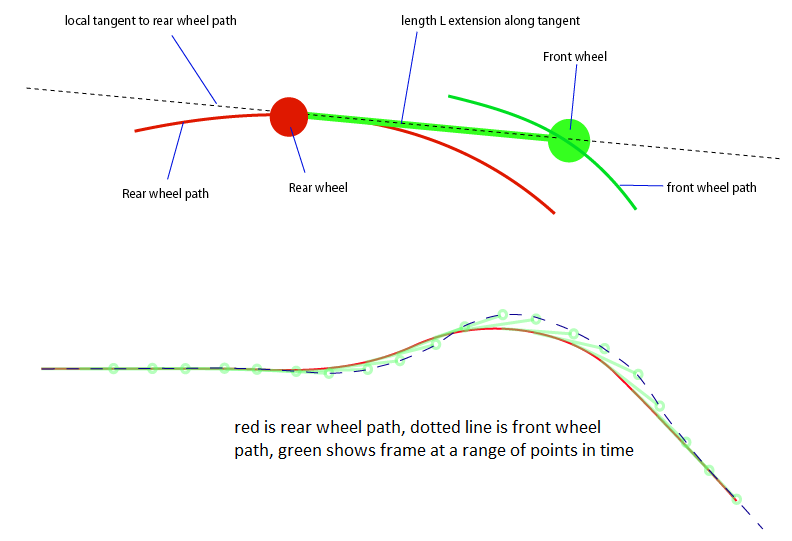The equation is an approximation to the wheel path - it ignores factors such as rake and the natural tilt that a bicycle takes when turning.
A reasonable model of a bicycle path is to consider the following:
- The rear wheel is mounted on a rigid frame oriented in the direction the rear wheel is moving.
- The front wheel is mounted at distance L forwards of the rear wheel, on the same rigid frame, but can pivot on a vertical axis.
As a result, the rear wheel is always pointing directly at the front wheel, so you can consider that at any time $t$, if the rear wheel is at a point $R(t)$, then the the front wheel is at a point distance $L$ along a line tangent to $R(t)$.
Maybe the picture below will help.
Addendum for F(t) -> R(t)
WRT the OP's question as to whether there is a solution for $R(t)$ as a function of $F(t)$, the relationship is not quite so simple. For any $R(t)$ (and its derivatives) there is exactly one solution for $F(t)$, but for any $F(t)$, $R(t)$ will depend on both $F(t)$ and some initial value for $R(t0)$. For example: consider $F(t) = (vt,0)$, i.e. the front wheel moves along teh $x$-axis at a constant velocity $v$.
A: If at $t=0$ the rear wheel is at $(-L,0)$, then the rear wheel will also track along the $x$-axis at velocity $v$.
B: If at $t=0$ the rear wheel is at $(0,L)$, then the rear wheel will initially move in the $-y$ direction and will follow a path vaguely remeniscent of an exponential decay that asymptotes to the $x$-axis at large $t$.
C: If at $t=0$ the rear wheel exactly at $(L,0)$, then the rear wheel will theoretically also track along the $x$-axis at velocity $v$. But that is an unstable equilibrium. Even the tiniest $y$ component in its initial position will result in the rear wheel curving off the $x$-axis, stopping momentarily at some $(x,L)$, and then following a path like that in B above.
Maybe another picture will help:


